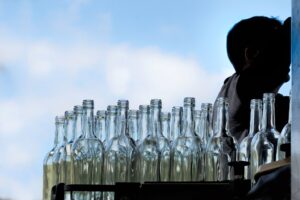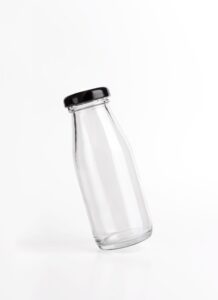1. Serious Defects
○ Hazardous to personal safety: shattered rims, and glass shards inside the bottle. Customers cannot use them normally. Such as severe deformation, or insufficient rim.
○ Glass filament inside the bottle: Also known as “calling”, a glass filament inside the bottle connecting the opposite sides.
○ Glass adhered to the external body of the bottle: The outer surface of the bottle with adhered glass is usually quite sharp. This occurs when the bottle is hot during the hot-end forming. And two bottles stick to each other upon contact. They separate when cooled.
○ Glass adhered inside the bottle: Occurs during hot-end forming along with stuck punch material and sharp spikes inside the bottle. Glass adhered inside refers to glass chunks falling and sticking to the inner surface of the bottle at high temperatures. Potentially also appearing on the body of the bottle. Stuck punch material refers to a small, sharp glass bump on the inner wall of the bottle head. Sharp spikes are sharp protrusions on the inner surface of the glass bottle, usually near the bottom.
○ Inner wall cracks (internal fissures): Arbitrary length and width cracks on the inner surface of the bottle, wide enough for a fingernail to enter. They resemble the shape of a crack line. Listed as a serious defect because it appears inside the body of the bottle. Some products require high-temperature sterilization or internal pressurization during which the crack disperses, creating glass shards and endangering safety.
○ Rim burrs (inner and outer double rim), inner rim burrs (rim burrs): Rim burrs on the inner diameter edge protrude as a ring of glass, commonly accompanied by an increased bottle height or uneven rim. Inner edge burrs: Tiny glass shards protruding upwards locally at the edge of the inner diameter. Affecting the seal of the cap and causing crushed glass to fall inside the bottle.
○ Thin skin bubbles (broken bubbles): Bubbles on the inner and outer parts of the bottle or the sealing surface of the rim, which burst under normal use due to being too soft, penetrable with a fingernail.
○ Mold burrs: Higher burrs protruding along the seam line of the bottle.
○ Insufficient rim: Incomplete formation of the top of the bottle rim.
2. Rim Defects
○ Flanged rim (convex rim) and damage to rim mold: Glass piece horizontally protruding outwards from the outer edge of the rim.
○ Rim mold damage: A small glass bump protrudes at the seam line of the rim and the sealing surface, as well as the initial mold interface, measured with calipers directly on the defective area. Usually resulting in an oversized outer diameter or affecting the smoothness of automatic capping.
○ Rim cracks (deep burst rim), fine cracks on the sealing surface of the rim (shallow burst rim): A deep burst rim is different from a shallow burst rim; it bursts deeper, and the cracks often extend from the inner edge to the outer edge. Shallow burst rims are shallow cracks at the top edge of the rim, visible only under refracted light from the rim. These are easily missed during inspection. For products with high sealing requirements, such as beverage bottles, chicken essence bottles, bird’s nest bottles, etc., after filling and capping bottles with shallow burst rims and storing them for three to five days, the vacuum safety button may protrude, indicating a leak, and the contents may spoil. Rim dent (concave rim), also known as “tooth through”.
○ Large inner diameter of the rim. Tooth through: The glass distribution on the inner wall of the rim is uneven, causing deformation, and it feels distinctly concave when touched. Large inner diameter: The inner diameter of the rim is larger than the design requirements. These defects can cause leakage when using internal plugs.

3. Neck Defects
○ Tong marks (clamping cracks) and neck cracks (burst neck): Tong marks are cracks caused by clamping, shaped like a crescent and occurring at the base of the neck. A burst neck is a horizontal crack on the neck.
○ Neck folding, neck grabbing, shoulder/neck collapse: Obvious deep creases on the glass surface, typically appearing on the neck. Neck grabbing refers to deformation of the neck, and shoulder/neck collapse refers to insufficient air blowing in the neck or shoulder.
○ Crooked neck, crooked body: Crooked neck is when the neck is not straight, affecting the parallelism index. Measured with a height gauge, the difference between the highest and lowest points can determine the degree of crookedness. Crooked body refers to the deviation between the central line of the rim and the vertical axis from the base, detectable with a vertical axis turntable but not with a height gauge.
4. Body Defects
○ Burst body, shallow burst body: A type of short and deep crack formed when the hot bottle surface contacts cold metal or other objects after molding, the crack is reflective. A shallow burst body is a shallow crack on the glass surface, varying in length, not penetrating deep into the glass, and not reflective.
○ Body crack line: A crack opening on the outer surface of the body. Felt by touch.
○ Cold mold: Due to the mold temperature being too cold, causing the glass surface to be rough and unevenly distributed, creating a tactile sense of unevenness.
○ Wrinkles: Small horizontal wrinkles on the external part of the bottle, typically dense and horizontal.
○ Folds: Minor folds on the glass surface, usually nearly horizontal.
○ Drop marks: Glass imprint formed at the top of the bottle by dropping the glass. Surrounding areas may have bubbles. The shape is irregular.
○ Bottle body indentations: After the bottle is formed, the bottle wall is squeezed, forming noticeable or subtle indentations. This causes the roundness of the bottle body to exceed standards or the diameter at certain points to be smaller.
○ Small bottle body: The overall diameter of the body is smaller than the lower standard limit, which could lead to insufficient capacity or inability to affix labels.
○ Hot mold crack: Typically appears on the body. Shaped like a seagull.
○ Burst seam line: Typically appears on the body, a crack at the seam line of the mold.
○ Burst shoulder: Vertical crack at the bottle shoulder.
○ Deep root crack: A deep crack at the base of the bottle.
○ Initial mold damage: A sharp glass indentation on the outer part of the bottle.
○ Final mold damage: Glass protrusion on the outer part of the bottle.
○ Burst lettering: Shallow cracks extending outward around the engraving.
○ Burst positioning: Cracks around the positioning.

5. Base Defects
○ Base crack: Shallow cracks at the base of the bottle.
○ Burst base: Deep cracks in any direction at the base, often radial and numerous.
○ Concave base: The center of the base is abnormally concave.
○ Convex base: The center of the base protrudes outward, causing the bottle to wobble when placed on a flat surface.
○ Uneven base: Due to deformation of the base, making it unstable when standing on a flat surface. Wobbles.
○ Mold base damage: Due to damage to the bottom mold, causing the glass at that part of the base to protrude.
○ Mold base line: Glass seeping into the seam between the forming mold and the base mold or due to poor fit of the base mold, forming burrs.
○ Misaligned plunger line: The plunger line is not centered on the base, skewed to one side.
○ Skewed base: The interior of the base appears wavy and tilted, but the tilt exceeds the specified requirements. Typically, the skew ratio is controlled at 1:2mm.
○ Thin base: The glass at the base is insufficient, not meeting the designed thickness, sometimes causing a skewed base to also result in a thin base.
6. Seam Line Defects
○ Seam line crack (burst seam line): A vertical crack at the seam line of the forming mold. It differs in shape from a hot mold crack.
○ Initial mold seam line defect: The bottle body’s seam line protrudes and is sharp. After forming, the initial mold line is indented.
○ Final mold seam line burrs: Burrs protruding at the seam of the final mold, opposite in shape to the initial mold seam line.
○ Mold misalignment: The two halves of the mold do not fit well, creating a stepped seam line. One side higher than the other.
○ Deep plunger thread: Glass entering the seam between the initial mold and the plunger, forming a noticeable serrated seam. Visually, the plunger line is clearly indented.
○ Plunger burrs (damaged plunger line): At the junction of the plunger and the iron bowl, a serrated protrusion forms on the plunger line.
○ Mouth/initial mold seam line burrs: The junction between the mouth and the iron bowl is rough, forming a raised, step-like, or serrated seam.

7. Measurement Defects
○ Oversized body: The diameter of the body exceeds the standard upper limit. A concave body may also cause the diameter at certain points to be too large.
○ Neck blockage (narrow neck): The inner diameter of the neck is smaller than specified. Some products specify the effective length of the internal stopper on the design drawings; a narrow neck is unacceptable for these. Non-special products are judged visually.
○ Inner ring of the neck: A concentric glass ring on the neck or upper part of the body.
Small inner diameter of the mouth: The inner diameter of the mouth is smaller than required. Measured with a plug gauge or caliper. Double inner rim may cause the inner diameter to be too small.
○ Excessive height: The height of the bottle exceeds the standard upper limit. And elongation of the neck may also cause the bottle height to exceed standards.
○ Short bottle: The height of the bottle does not meet the standard minimum. Excessive shrinkage or seating of the base may result in a short bottle.
○ Non-round body: The ovality is the deformation of the bottle body cross-section from round to oval. Typically represented by the difference between the long and short axes. That is, the difference between the largest and smallest values when rotating the same initial measurement surface exceeds the standard range for non-roundness.
○ Bulging body: Deformation of the body, bulging outwards beyond the specified requirements.










